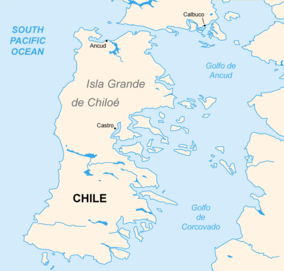Alfaguara project
| Alfaguara | |
|---|---|
|
IUCN category V (protected landscape/seascape)
|
|

Anay Rocks on the west coast of the Isla Grande de Chiloé
|
|
 |
|
| Location | Chile, Pacific Ocean |
| Coordinates | 42°22′37″S 74°32′22″W / 42.376807°S 74.53949°WCoordinates: 42°22′37″S 74°32′22″W / 42.376807°S 74.53949°W |
| Established | 2008 |
| www |
|
The Alfaguara project is a marine life conservation project operated from Puñihuil in the northwest of Isla de Chiloé, southern Chile. "Alfaguara" was the name given to blue whales by Chilean whalers. The focus of the project is on preservation of these endangered animals, the largest in the world. The project is operated by the Centro de Conservacion Cetacea (CCC), established in 2001. Its studies have made the Isla de Chiloé blue whale population one of the best understood in the southern hemisphere.
The Alfaguara Project was launched in 2004 and combines a long-term program of scientific research with local education and community building. It looks for ways to use whales in Chilean waters and preserve the marine ecosystem that do not involve killing the whales. It is recognized as a marine conservation initiative of national interest. In 2008 the government of Chile agreed with the Alfaguara Project's request to establish a whale sanctuary following a poll in which 98% of citizens voted in favor.
The project depends on the informed participation of the northwest coastal community of Isla Grande de Chiloe and also involves national authorities and international experts. It is sponsored by the General Directorate of Maritime Territory and Merchant Marine and the Ministry of Foreign Affairs. It has been assisted by the Rufford Maurice Laing Foundation, Global Ocean and the Mohamed bin Zayed Species Conservation Fund. The Pacific Whale Foundation provided funding for the 2012 season.
The waters to the northwest of the Isla Grande de Chiloe, which is the largest land body in the Chiloé Archipelago lying off Gulf of Corcovado near the coast of Northern Patagonia in Chile, are an important long-term feeding area for blue whales. In the period between 1926 and 1967 whaling ships slaughtered about 97% of the blue whales in the southern Pacific. The relatively small and isolated population remaining near the Isla de Chiloe is threatened by the risk of collision from increasing volumes of shipping, noise and pollution from a Norwegian salmon farming operation and possibly from rising ocean temperatures leading to changes in the food species available to the whales.
...
Wikipedia
